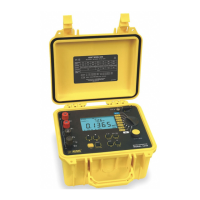20
Micro-Ohmmeter Model 6250
4.2.2 Programming the 9-Pin Interface Port (rS)
The 9-pin interface port on the top right side of the front panel can be pro-
grammed to any of ve communication methods. These consist of:
1.
O: Disable input and output functions of the interface port. This
choice saves battery power.
2. Trigger: Enables the remote measurement function.
3. PC: Activates an RS-232 link between a computer and the unit for
conguring the Model 6250 and for conducting tests and storing
results. When activated, the
icon will appear on the display.
4. VT100: Activates an RS-232 link between a display terminal and
the Model 6250. When activated, the
icon will appear on the
display.
5. Print: Activates the RS-232 link between a printer and the Model
6250 for direct printing of test results. When activated, the
icon
will appear on the display.
The RS-232 modes also allow programming of transmission speed. The
baud rate choices are: 4800, 9600, 19200 and 31250.
The required data conguration settings are: 8 bits, no parity, 1 stop bit,
hardware control (CTS).
• Turn the rotary switch to the SET-UP position.
• Press the
▲ button
until “rS” appears on the top line of the
display.
• Press the ►
button
, OFF will appear in the display.
• Press the ► button to accept this setting or press the
▲ button
to scroll through the other choices of trigger (trlG), PC, Terminal
(ut100) and Print.
• The choices of PC, terminal and print also require a baud rate
selection.
• After selecting PC, ut100 or Print, pressing the ► button will enter
the baud rate selection menu.
• Press the
▲ button
to toggle the choices for 4800, 9600, 19200
and 31250. When the desired baud rate is in the display, validate
it by pressing the ► button to return to the top level rS menu. The
icon will appear in the display.
• Proceed to the next programming variable by pressing the
▲
button
.
w ww . . co m
information@itm.com1.800.561.8187

